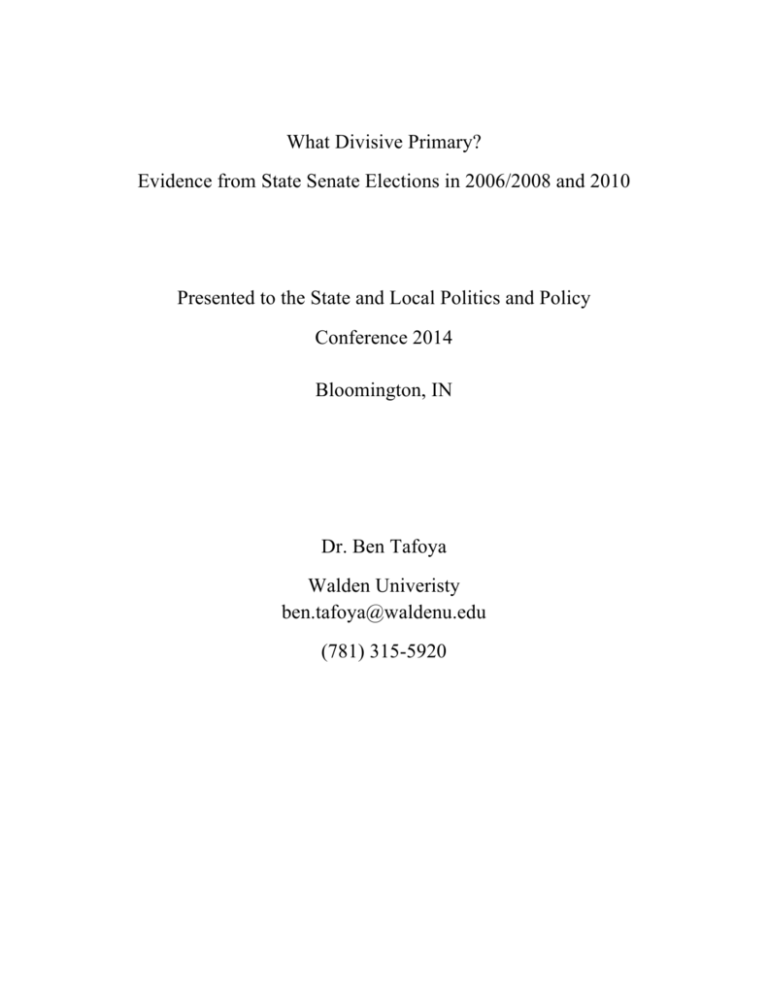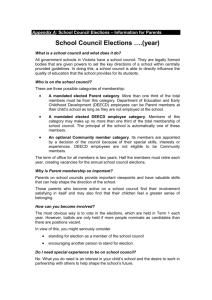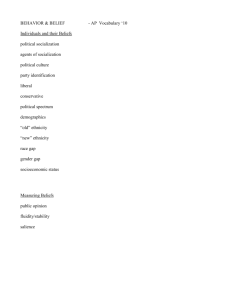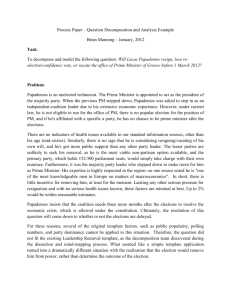Contested Primaries: A Review and Comparison from 2006/2008
advertisement

What Divisive Primary? Evidence from State Senate Elections in 2006/2008 and 2010 Presented to the State and Local Politics and Policy Conference 2014 Bloomington, IN Dr. Ben Tafoya Walden Univeristy ben.tafoya@waldenu.edu (781) 315-5920 Ben Tafoya What Divisive Primary? 2 Abstract Conventional political wisdom states that candidates without primary opponents have a built-in advantage against general election opponents that must run vigorous primary elections. The existing academic literature is split in this contention. This paper examines the result of state senate elections from 2010 to test the hypothesis of this assumption. It finds an important confounding factor with respect to previous research efforts – party of the previous incumbent – as a more significant predictive factor than competitive primaries. Further analysis compares the district-based results from 2010 with their previous cycle in either 2006 or 2008. The paper holds open the possibility that the effect will vary depending on whether we look at district-based or statewide elections. Ben Tafoya What Divisive Primary? 3 Introduction There is a view, supported by the literature and conventional wisdom, which holds that primaries negatively impact a candidate’s chances for election (Bernstein, 1977; Johnson, 2010). Primaries can result in party divisiveness, which means that candidates have a more difficult challenge to unite their party for general election purposes. An alternative view emerged that argued, primaries are an opportunity to increase name recognition, fundraise, and refine political messaging (Lazarus 2005). To test the competing assertions, the researcher examined open seat state senate races in 2010 that involved competitive primaries for one candidate and no primary for the other. Open seats have typically more opportunities for primaries than races involving incumbents. The research included a comparison of party vote totals between the last election cycle of the previous incumbent (either 2006 or 2008 depending on the state) and the general election of 2010. The literature on primary election activities is equally split on the issue of divisiveness. Piereson and Smith (1975) examined Gubernatorial elections throughout the US from 1956 through 1964 and found no support for the divisive primary hypothesis. In fact they find a small positive effect for competitive primaries on the prospects of non-incumbents. Their results mirror those of Hacker (1965) who concluded that a divisive primary bore little relation to the general election result. However, Piereson and Smith’s methodology was significantly different in that they measured the nominal impact of primaries on the general election vote, rather than simply winning and losing, the approach used by Hacker. It is important to point out that both studies looked at statewide elections while this work concentrates on district-based elections. A study by Born (1981) on US House of Representatives primary elections found no impact of primaries on Ben Tafoya What Divisive Primary? 4 non-incumbent races. Yet V.O. Key (1964) expressed concerns about the impact of primaries on stable party structures and increased intra-party factions. Key’s conclusions were carried over into recent work by Makse and Sokhey (2010) where they examined the outcome of the 2008 Democratic Primary match between Clinton and Obama. They concluded that the divisiveness of the historically close nomination contest could have cost Obama the presidency absent the economic crisis. Yet Wichowsky and Niebler (2010) examined the competitiveness of presidential primary contests and the divisiveness (as a function of negative advertising) and came to the conclusion that Obama was helped by participation in close primary contests in the subsequent general election vote. What the researcher found through the course of the work was surprisingly clear based on this record; the data suggests that in the examined races (open elections for State Senate), the presence of a primary had little impact on the outcome of the race. That is, primaries had a statistically insignificant impact on the outcome of the subsequent general election. Instead, it was found that the party of the previous incumbent served as the strong indicator of which party would win the open seat election. The findings from 2010 were tempered somewhat by the presence of a Republican wave. Research Methods and Results The 2010 legislative elections were characterized by a distinctive wave in the direction of Republican candidates. Republicans gained control of six State Senate chambers that were previously controlled by Democrats. One upper chamber remained a tie (Alaska Senate). Lower houses passed into Republican control in 14 states and one moved from Democrats to a tie. Ben Tafoya What Divisive Primary? 5 According to the National Council of State Legislators, Republicans gained a total of 675 seats in both lower and upper chambers and as a result in 2011 Republicans held their highest number of legislative seats since 1928 (NCSL 2013). This study examined open seat elections for State Senate across the universe of 2010 elections. State Senate level elections were chosen because of the preponderance of single member districts, which made measuring the impact of primaries possible. In 2010, 46 states held State Senate elections including Nebraska’s non-partisan, unicameral legislature (which was excluded from the data). Analysis focused on those states where there were open seat elections as a result of the incumbent office holder choosing not to stand for re-election or who were sidelined because of term limits. Election data came from historical records maintained by Ballotpedia, The Almanac of State Legislative Races 2000-2006 and various state election officers. The resulting races were broken down to find those instances where there was one party nominee with a primary and an opponent that did not have a contested primary. The null hypothesis was that candidates with a contested primary were at a competitive disadvantage in their general elections against opponents without a primary opponent. Further screening was done to determine a “competitive primary” as those where the victor had less than 67% of the vote. This left 93 races for consideration in this population. Table 1 Ben Tafoya What Divisive Primary? 6 As shown in Table 1, Republicans won 56 of the 93 seats up for election from the population. Of those 56 victors, 45 of them had contested primaries. Of the 37 victories by Democrats, 32 had primaries with the other five seats won by candidates not engaged in contested primaries. Overall 82.8% (77/93) of the winners of general elections in open seat contests in 2010 had competitive primaries leaving those without a primary and facing an opponent who had a primary only winning 17.2% (16/93) of the general elections. Based on this result we rejected the null hypothesis and concluded that having a contested primary in an open seat election where the winning candidate’s opponent did not have a primary is not a disadvantage. The research then focused on what factors could play a role in this result. Why do candidates with primaries fare better in general elections than their opponents who do not have a primary challenge? The research examined a potential salient factor that could determine the outcome of general elections despite the presence or absence of a primary election. Is the district drawn in such a way that one party is favored to retain the position in the event of an open seat election? The 93 districts were re-examined based on the party of the previous incumbent and the results are shown in Table 2. Ben Tafoya What Divisive Primary? 7 Table 2 The data shows that the party of the previous incumbent is a strong predictor of the results of an open seat election. Democrats only won one seat that was previously held by a Republican and 36 of their 37 victories were in districts previously held by a Democrat. Democrats won 31 out of 41 seats where they were defending a seat previously held by a Democrat and there was a primary. Democrats lost 7 out of 12 seats where they were defending a seat previously held by a Democratic incumbent and there was no primary on the Democratic side. The Republican wave was demonstrated in this analysis as they held all 35 seats vacated by a Republican incumbent and where they had a primary and the Democrats had none. They also won 4 out of 5 seats where they had no primary and there was a primary on the Democratic side for a seat previously held by a Democrat. The conclusion is that being a member of the same party as the previous office-holder is a better predictor of electoral success than whether there was a primary election, overall 75 out of 93 state Senate general election contests were won in 2010 by a candidate from the same party as the previous incumbent. Ben Tafoya What Divisive Primary? 8 Taking a broader universe of contests the researcher added in all races for open seats regardless of primary status. This universe including the previous contests (primary in one party and no primary in the other) and also included those where there were contested primaries in both parties and contested primaries in neither party. A linear regression on the 182 contests showed in Table 3 present a strong result for the party of the previous incumbent as a factor and the primary as insignificant. Table 3 Regression Model for Open Seat Outcomes Model Unstandardized Coefficients B 1 Standardized Coefficients (Constant) .434 Std. Error .040 Beta t 10.837 Sig. .000 Incumbent Party .504 .062 .532 8.114 .000 Primary .063 .073 .057 .870 .385 a. Dependent Variable: Winner Party ! The relationship between election cycles is shown in Appendix 1 and 2. The results from the previous election cycle are depicted (either 2006 or 2008 depending on the state versus 2010). In the first set the population is the subset (N = 134) of the 182 races where there was actual competition in the previous election cycle. This eliminated 48 races which were uncontested by one party or another. The graph shows the two-party vote percentage going to the Republican candidate in the general election. As can be seen by inspection there is a Republican Ben Tafoya What Divisive Primary? 9 advantage in 2010 over the previous election cycle. In a paired samples test the difference between the Republican vote in both sets of cycles is 7.5%. The correlation is .753. Looking at the Republican vote, in those districts previously held by a Republican the average vote across all districts in 2010 was 64%. In districts previously held by a Democrat the total was 46%. In Appendix 2 the same pattern is shown but for only those contests where there is a primary in one party and not the other. With an N = 78 after winnowing to those contests that had valid results in both cycles and where there was a primary in only one party the vote difference widens to 8.3% and the correlation is .84. Threats to Validity and Further Research There are concerns of internal and external validity with this study. The greatest internal threat was deemed to be historical as all observations were of races in 2010. This last election cycle was a decided wave election in favor of Republican candidates. If the results were viewed in elections with countervailing waves (such as 2006 or 2008 looking back against 2004, etc…) or no waves then there is a possibility of differing results. Moreover, because of the filter and the sample from one election cycle, the sample is small. External validity is also a concern as this study examined district level elections for state offices (State Senate) and may be difficult to apply to other district level elections (such as US Congress) or statewide, non-district elections. Previous research showed the impact of an intra-party primary on incumbent officeholders was negative, but that the situation described here, open seat elections, attracts more primary opportunities (Hogan 2003). Moreover, the 2010 election cycle was the last under existing Ben Tafoya What Divisive Primary? 10 district configuration prior to re-apportionment. Will new districts after 2012 change the outcomes of analysis? It is certainly possible that the effect of partisan line drawing (gerrymandering) could deepen after this latest round of reapportionment. In an attempt to isolate some of concerns of validity in the study the research looked at whether the election results from the previous election cycle (either 2006 or 2008 depending on the state) influenced the relationship between the variables (party of the previous incumbent and primary). This study provides a good baseline on the performance of candidates with competitive primaries. Not all states had State Senate elections in 2010 so research can examine the results based on a set of elections in the new apportionment decade starting 2012 with elections in 2014. It would be instructive to examine results in light of a regional classification such as those proposed by Hogan (2003). Discussion of Results Early in the study the researcher rejected the null hypothesis regarding the importance of contested primaries in predicting the outcome of open seat elections for the State Senate. In the 38 states with open seat elections included in the study it was found that the stronger determining factor in success was not whether the candidates had primaries but rather the party of the previous incumbent. The cause of this factor was thought to be two-fold; under some circumstances the district lines are drawn to favor specific parties because of known voting behaviors of the residents in precincts, wards and towns (so-called gerrymandering) or because certain districts have unavoidable tendencies under contemporary political arrangements to vote for one party (ie…urban districts vote Democratic, rural districts vote Republican). This latter Ben Tafoya What Divisive Primary? 11 effect accentuated in smaller districts such as State Senate where only in California are they bigger than or the US House of Representatives. It is also possible that primaries do have some impact on the prospects of the party’s nominee but that effect is hidden, as it does not change the outcome but rather impacts the overall vote total. Based on the research this would suggest adopting a version of the conclusions supported by Piereson and Smith (1975), that under the circumstances of open seat, district based elections there is no difference in effect between looking at nominal outcome or nominal vote percentage. These findings were thought to be significant particularly in a reapportionment year. If contested primaries do not drain resources from candidates but rather provide the forum for the “true” election in certain districts then states may want to concentrate on drawing districts in such a manner as to minimize the gerrymandering of lines as general elections lose importance under the current scenario. Regionally based voting tendencies may be unavoidable (the urban and rural generalization above) as a consequence of contiguous districts. The question remains as to whether two-party competitive districts provide a stronger basis for the representation of the diversity of political opinions inside and outside the major parties. Experiments in non-political reapportionment such as California and Iowa and (19 other states) bear watching, as do the socalled non-partisan primaries in Washington and California for their impact on the strength of gerrymandering of districts Ben Tafoya What Divisive Primary? 12 Bibliography Bernstein, Robert A. "Divisive Primaries Do Hurt: Us Senate Races, 1956-1972." American Political Science Review 71, no. 2 (June 1977 1977): 15. Born, Richard. "The Influence of House Primary Election Divisiveness on General Election Margins, 1962?76." The Journal of Politics 43, no. 03 (1981): 640-61. Gregg B. Johnson, Meredith-Joy Petersheim and Jesse T. Wasson. "Divisive Primaries and Incumbent General Election Performance: Prospects and Costs in U.S. House Races." American Politics Research 38, no. 5 (2010): 24. Hacker, Andrew. "Does a “Divisive” Primary Harm a Candidate’s Election Chances?". American Political Science Review 1 (1965): 5. Hogan, Robert E. "The Effects of Primary Divisiveness on General Election Outcomes in State Legislative Elections." American Politics Research 31, no. 7 (January 2003): 20. Key, V. O. Jr. Politics, Parties, and Pressure Groups. 5th ed. New York: Thomas Y. Crowell, 1964. Lazarus, Jeffrey. "Unintended Consequences: Anticipation of General Election Outcomes and Primary Divisiveness." Legislative Studies Quarterly XXX, no. 3 (August 2005): 26. Legislators, National Council of State. "A Wave or a Ripple." http://www.ncsl.org/legislatureselections/elections/a-wave-or-a-ripple.aspx. Makse, Todd, and Anand E. Sokhey. "Revisiting the Divisive Primary Hypothesis: 2008 and the Clinton—Obama Nomination Battle." American Politics Research 38, no. 2 (March 1, 2010 2010): 233-65. Norrander, Barbara. "Primary Elections." In The Oxford Handbook of American Elections and Political Behavior, edited by Jan E. Leighley. 515-30. Oxford, UK: Oxford University Press, 2010. Smith, James E. Piereson and Terry B. "Primary Divisiveness and General Election Success: A ReExamination." The Journal of Politics 37, no. 2 (May 1975 1975): 7. Wichowsky, Amber, and Sarah E. Niebler. "Narrow Victories and Hard Games: Revisiting the Primary Divisiveness Hypothesis." American Politics Research 38, no. 6 (November 1, 2010 2010): 105271. Dr. Ben Tafoya is the Undergraduate Program Director at the Walden University School of Public Policy and Administration. He has previously been an Assistant Professor of Political Science at New England College in Henniker, NH. He has taught and supervised a range of undergraduate and graduate courses in political science, public policy and economics. His research interests include state and local public policy, economic policy and elections. He is a local elected official in Massachusetts. The author would like to thank his colleague Prof Wayne Lesperance of New England College for his help on an earlier version of the article, Jason Bloxham, a graduate of the political science program at New England College and Andrew Kluge a Political Science student at Suffolk University for their assistance with the research in the article.








